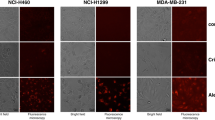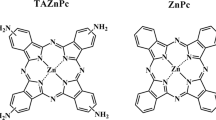Abstract
A promising clinical application of 5-aminolevulinic acid (5-ALA)-induced protoporphyrin IX (PP IX) is fluorescence detection and photodynamic treatment of residual tumour tissue during surgical resection of high grade malignant glioma. U373 MG human glioblastoma cells were used as a model system to study the relation between intracellular location and photodynamic efficacy of 5-ALA-induced PP IX in more detail. Therefore, ultra-sensitive fluorescence microscopy, using either optical excitation of whole cells or selective excitation of the plasma membrane by an evanescent electromagnetic field, was combined with quantitative measurements of intracellular porphyrin amount and phototoxicity. Glioblastoma cells accumulated PP IX to a moderate extent as compared to T47D breast cancer cells (high accumulation) or OV2774 ovarian cancer cells (low accumulation). Although photodynamic inactivation of the different cell lines (decreasing in the order T47D > U373 MG > OV2774) seemed to be directly related to PP IX accumulation, examination of the data in more detail revealed that photodynamic efficacy per photosensitizer molecule (PE) was about two times higher in glioblastoma and ovarian cancer cells as compared to breast cancer cells. The different photodynamic efficacy of PP IX was related to the different intracellular location. In contrast to breast cancer cells where PP IX fluorescence was localized in small granules, PP IX fluorescence in glioblastoma cells and ovarian cancer cells originated mainly from cellular membranes. Thus, the intracellular location of PP IX in a predominantly lipophilic environment, characterized by a comparably high photostability (probed by photobleaching and photoproduct formation) and a lower degree of porphyrin aggregation (probed previously by fluorescence decay kinetics), seems to be the key factor for high photodynamic efficacy of 5-ALA-induced PP IX. In the case of OV2774 ovarian cancer cells, however, a low PP IX accumulation limited cell inactivation upon irradiation, whereas the results obtained for glioblastoma cells are encouraging to develop PDT to an additional therapeutic option for the treatment of tumour margins in patients who underwent fluorescence-guided resection of high grade malignant glioma after 5-ALA administration.
Similar content being viewed by others
References
T. J. Dougherty, Photosensitizers: therapy and detection of malignant tumours, Photochem. Photobiol., 1987, 45, 879–889.
Z. Malik, H. Lugaci, Destruction of erythroleukaemic cells by photoinactivation of endogenous porphyrins, Br. J. Cancer, 1987, 56, 589–596.
J. C. Kennedy, R. H. Pottier, D. C. Pross, Photodynamic therapy with endogenous protoporphyrin IX: basic principles and present clinical experience, J. Photochem. Photobiol., B, 1990, 6, 143–148.
M. Kondo, N. Hirota, T. Takaoka, M. Kajiwara, Heme-biosynthesis enzyme activities and porphyrin accumulation in normal and hepatoma cell lines of rats, Cell Biol. Toxicol., 1993, 9, 95–105.
Y. Ohgari, Y. Nakayasu, S. Kitajima, M. Sawamoto, H. Mori, O. Shimokawa, H. Matsui, S. Taketani, Mechanisms involved in delta-aminolevulinic acid (ALA)-induced photosensitivity of tumor cells: relation of ferrochelatase and uptake of ALA to the accumulation of protoporphyrin, Biochem. Pharmacol., 2005, 71, 42–49.
S. M. Wu, Q. G. Ren, M. O. Zhou, Q. Peng, J. Y. Chen, Protoporphyrin IX production and its photodynamic effects on glioma cells, neuroblastoma cells and normal cerebellar granule cells in vitro with 5-aminolevulinic acid and its hexylester, Cancer Lett., 2003, 200, 123–131.
F. Duffner, R. Ritz, D. Freudenstein, M. Weller, K. Dietz, J. Wessels, Specific intensity imaging for glioblastoma and neural cell cultures with 5-aminolevulinic acid-derived protoporphyrin IX, J. Neuro-Oncol., 2005, 71, 107–111.
W. Stummer, S. Stocker, A. Novotny, A. Heimann, O. Sauer, O. Kempski, N. Plesnila, J. Wietzorrek, H. J. Reulen, In vitro and in vivo porphyrin accumulation by C6 glioma cells after exposure to 5-aminolevulinic acid, J. Photochem. Photobiol., B, 1998, 45, 160–169.
K. M. Hebeda, A. E. Saarnak, M. Olivo, H. J. Sterenborg, J. G. Wolbers, 5-Aminolevulinic acid induced endogenous fluorescence in 9L and C6 brain tumours and in normal rat brain, Acta Neurochir. (Wien), 1998, 140, 503–512.
W. Stummer, S. Stocker, S. Wagner, H. Stepp, C. Fritsch, C. Götz, A. Götz, R. Kiefmann, H. J. Reulen, Intraoperative detection of malignant gliomas by 5-aminolevulinic acid induced porphyrin fluorescence, Neurosurg., 1998, 42, 518–526.
W. Stummer, A. Novotny, H. Stepp, C. Goetz, K. Bise, H. J. Reulen, Fluorescence-guided resection of glioblastoma multiforme by using 5-aminolevulinic acid-induced porphyrins: a prospective study in 52 consecutive patients, J. Neurosurg., 2000, 93, 1003–1013.
A. Bogaards, A. Varma, S. P. Collens, A. Lin, A. Giles, V. X. Yang, J. M. Bilbao, L. D. Lilge, P. J. Muller, B. C. Wilson, Increased brain tumor resection using fluorescence image guidance in a preclinical model, Lasers Surg. Med., 2004, 35, 181–190.
S. J. Madsen, C. H. Sun, B. J. Tromberg, V. P. Wallace, H. Hirschberg, Photodynamic therapy of human glioma spheroids using 5-aminolevulinic acid, Photochem. Photobiol., 2000, 72, 128–134.
H. Hirschberg, C. H. Sun, B. J. Tromberg, S. J. Madsen, ALA- and ALA-esters-mediated photodynamic therapy of human glioma spheroids, J. Neuro-Oncol., 2002, 57, 1–7.
B. Olzowy, C. S. Hundt, S. Stocker, K. Bise, H. J. Reulen, W. Stummer, Photoirradiation therapy of experimental malignant glioma with 5-aminilevulinic acid, J. Neurosurg., 2002, 97, 970–976.
S. Ito, W. Rachinger, H. Stepp, H. J. Reulen, W. Stummer, Oedema formation in experimental photo-irradiation of brain tumors using 5-ALA, Acta Neurochir. (Wien), 2005, 147, 57–65.
H. Hirschberg, D. R. Sorensen, E. Angell-Petersen, Q. Peng, B. Tromberg, C. H. Sun, S. Spetalen, S. Madsen, Repetitive photodynamic therapy of malignant brain tumors, J. Environ. Pathol. Toxicol. Oncol., 2006, 25, 261–280.
E. Angell-Petersen, S. Spetalen, S. J. Madsen, C. H. Sun, Q. Peng, S. W. Carper, M. Sioud, H. Hirschberg, Influence of light fluence rate on the effects of photodynamic therapy in an orthopic rat glioma model, J. Neurosurg., 2006, 104, 109–117.
A. Fautrel, C. Chesné, A. Guillouzo, G. de Sousa, M. Placidi, R. Rahmani, F. Braut, J. Pichon, H. Hoellinger, P. Vintézou, I. Diarte, C. Melcion, A. Cordier, G. Lorenzon, M. Benicourt, B. Vannier, R. Fournex, A. F. Peloux, N. Bichet, D. Gouy, J. P. Cano, R. Lounes, A multicentre study of acute in vitro cytotoxicity in rat liver cells, Toxicol. in vitro, 1991, 5, 543–547.
A. L. Vandenbogaerde, J. F. Cuveele, P. Proot, B. E. Himpens, W. J. Merlevede, P. A. de Witte, Differential cytotoxic effects induced after photosensitization by hypericin, J. Photochem. Photobiol., B, 1997, 38, 136–142.
K. Stock, R. Sailer, W. S. L. Strauss, M. Lyttek, R. Steiner, H. Schneckenburger, Variable-angle total internal reflection fluorescence microscopy (VA-TIRFM): realization and application of a compact illumination device, J. Microsc., 2003, 211, 19–29.
H. Schneckenburger, M. H. Gschwend, R. Sailer, H.-P. Mock, W. S. L. Strauss, Time-gated fluorescence microscopy in molecular and cellular biology, Cell Mol. Biol, 1998, 44, 795–805.
C. G. Coates, D. J. Denvir, N. G. McHale, K. G. Thornbury and M. A. Hollywood, Ultrasensitivity, speed and resolution: optimizing low-light microscopy with the back-illuminated electron-multiplying CCD, in Confocal, Multiphoton, and Nonlinear Microscopic Imaging, ed. T. Wilson, The International Society for Optical Engineering, Bellingham, USA, 2003, vol. 5139, pp. 56–66.
H. Schneckenburger, M. Wagner, M. Kretzschmar, W. S. L. Strauss, R. Sailer, Laser-assisted fluorescence microscopy for measuring cell membrane dynamics, Photochem. Photobiol. Sci., 2004, 3, 817–822.
P. Weber, M. Wagner, H. Schneckenburger, Microfluorometry of cell membrane dynamics, Cytometry, 2006, 69A, 185–188.
J. Moan, G. Streckyte, S. Bagdonas, O. Bech, K. Berg, Photobleaching of protoporphyrin IX in cells incubated with 5-aminolevulinic acid, Int. J. Cancer, 1997, 70, 90–97.
J. D. Dysart, M. S. Patterson, Photobleaching kinetics, photoproduct formation, and dose estimation during ALA induced PP IX PDT of MLL cells under oxygenated and hypoxic conditions, Photochem. Photobiol. Sci., 2006, 5, 73–81.
W. S. L. Strauss, R. Sailer, M. H. Gschwend, H. Emmert, R. Steiner, H. Schneckenburger, Selective examination of plasma associated photosensitizers using total internal reflection fluorescence spectroscopy (TIRFS)-correlation between photobleaching and photodynamic efficacy of protoporphyrin IX, Photochem. Photobiol., 1998, 67, 363–369.
R. Sailer, W. S. L. Strauss, H. Emmert, M. Wagner, R. Steiner and H. Schneckenburger, Photodynamic Efficacy and Spectroscopic Properties of 5-ALA Induced Protoporphyrin IX in Human Glioblastoma Cells, in Optical Methods for Tumour Treatment and Detection: Mechanisms and Techniques in Photodynamic Therapy, ed. D. Kessel, The International Society for Optical Engineering, Bellingham, USA, 2005, vol. 5689, pp. 123–129.
H. Schneckenburger, K. König, K. Kunzi-Rapp, C. Westphal-Frösch, A. Rück, Time-resolved in vivo fluorescence of photosensitizing porphyrins, J. Photochem. Photobiol., B, 1993, 21, 143–147.
Author information
Authors and Affiliations
Corresponding author
Rights and permissions
About this article
Cite this article
Sailer, R., Strauss, W.S.L., Wagner, M. et al. Relation between intracellular location and photodynamic efficacy of 5-aminolevulinic acid-induced protoporphyrin IX in vitro. Comparison between human glioblastoma cells and other cancer cell lines. Photochem Photobiol Sci 6, 145–151 (2007). https://doi.org/10.1039/b611715e
Received:
Accepted:
Published:
Issue Date:
DOI: https://doi.org/10.1039/b611715e




